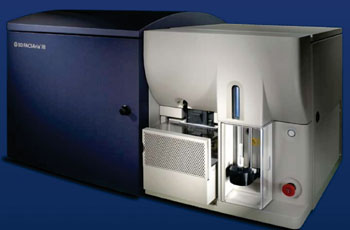Immune Cells Adapt Inefficiently in Patients with Uncontrolled HIV
By LabMedica International staff writers
Posted on 28 Mar 2016
Antibodies derived from a type of immune cell found in unusually high numbers in human immunodeficiency virus (HIV)-infected individuals with chronically uncontrolled virus levels are less effective at neutralizing HIV than antibodies derived from a different type of immune cell more common in people without HIV.Posted on 28 Mar 2016
HIV infection leads to numerous immunologic abnormalities, especially in individuals whose viremia is not well controlled, either naturally or by antiretroviral therapy (ART). B cells are not direct targets for HIV replication; however, direct and indirect consequences of viral replication such as immune activation and lymphopenia lead to numerous B cell abnormalities over the course of infection.

Image: The FACSAria III cell sorter instrument (Photo courtesy of BD Biosciences).
Scientists at the US National Institute of Allergy and Infectious Diseases (Bethesda, MD, USA) and their colleagues collected serum and/or leukapheresis products from 25 chronically infected HIV-viremic individuals. The donors were not taking antiretroviral drugs to suppress the level of HIV in their blood, or viral load, at the time of the study. Like many individuals with persistent levels of HIV, the donors' blood samples had abnormally high numbers of immune cells called tissue-like memory (TLM) B cells, compared with resting memory (RM) B cells, which account for the majority of memory B cells in people without HIV.
Peripheral blood mononuclear cells (PBMCs) were obtained by density-gradient centrifugation. Mature CD10-B cells were isolated from PBMCs by negative magnetic bead–based selection using a B cell enrichment cocktail that was supplemented with tetrameric anti-CD10 monoclonal antibodies (mAb) (STEMCELL Technologies; Vancouver, BC, Canada). Immunophenotyping to identify suitable subjects for sorting was performed using the following anti-human mAbs. Fluorescent activated cell sorting (FACS) analyses were performed on a FACSCanto II flow cytometer and sorting of B cell populations and of single HIV-specific B cells into 96-well polymerase chain reaction (PCR) plates was performed on a modified 3-laser FACSAria instrument (BD Biosciences; San Jose, CA, USA).
Generally, as B cells divide in response to a pathogen like HIV, genes that produce infection-fighting antibodies mutate, and descendant cells producing the most effective antibodies predominate. Despite the fact that TLM B cells generally divided more frequently than their RM counterparts, the scientists found that the antibodies derived from TLM B cells showed genetic evidence of fewer adaptive mutations than those derived from RM B cells. In turn, these antibodies were less likely to effectively neutralize HIV than those derived from RM B cells. The RM B cells, in contrast, showed evidence of generating antibodies with more helpful mutations.
The authors concluded that nonconventional TLM B cells overrepresented in the peripheral blood of chronically infected HIV-viremic individuals show reduced affinity maturation compared with their clonally related conventional RM counterparts, despite evidence of having undergone more cell divisions. The study was published on March 17, 2016, in the journal JCI Insight.
Related Links:
US National Institute of Allergy and Infectious Diseases
STEMCELL Technologies
BD Biosciences














